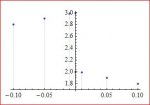I'm confused...
Say you have a question such as this one:
My personal opinion is that the limit does not exist, since you are given the values; the limits should be undefined, yet at x -> 0 the value is clearly 3 (which, by the way, is a wrong answer.
Similarly, this confuses me.
Say you have a question such as this one:
The function values for g(x) near x = 0 are given in the table below.
Use the table of values to evaluate 
| |||||||||||||||||
|
My personal opinion is that the limit does not exist, since you are given the values; the limits should be undefined, yet at x -> 0 the value is clearly 3 (which, by the way, is a wrong answer.
Similarly, this confuses me.
| . | Suppose f (x) is a function such that 
I. f (5) = 0 II. f (5) = 2 III. f (5) is undefined | ||||||||
|

